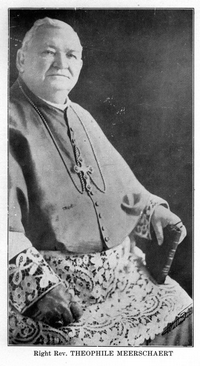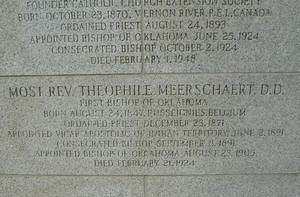|

Right Rev. THEOPHILE MEERSCHAERT
(1847-1924)
Born in Russignies, near Renaix, Flanders (Belgium), on
August 24, 1847, he entered the College of Renaix, remaining
there from 1859 to 1864. From 1864 to 1868 he attended College
in Audenarde. He then entered the American College of Louvain,
remaining there until 1872, receiving Minor Orders on June 10,
1870. He was ordained Sub-deacon on December 17, 1870, Deacon
June 3, 1871, and Priest December 23, 1871.
Father Meerschaert left Russignies for the United States on
September 26, 1872, arriving in New York City on October 13,
1872, and at Natchez, Mississippi, October 27th. He was
appointed to Missions of Jordan River, of Wolf River and Pearl
River, in Hancock and Harrison Counties, Mississippi, on
November 16, 1872, and changed to Ocean Springs, August 29,
1874. In October, 1875, Father Meerschaert, that section being
swept by a yellow fever epidemic, at his post of duty was
stricken with yellow fever. Recovering he nursed those so
afflicted for eight weeks, when he had a relapse. After
recovering and a vacation for rest he resumed his duties. In
1878 with a recurrence of yellow fever on the Gulf Coast he
assisted the sufferers at Ocean Springs and Biloxi, Mississippi.
In 1879 he was sent to Bay St. Louis, Mississippi, to replace
Rev. Father Leduc for one year.
On August 30, 1880, Father Meerschaert assigned to Natchez,
became Vicar General on April 18, 1887. Bishop Janssens having
been appointed to the Archiepiscopal See of New Orleans, 1888,
Vicar-General Meerschaert was appointed administrator.
On May 7, 1891, Father Meerschaert was preconized Vicar
Apostolic of the Indian Territory and titular Bishop of Sidyma.
The Bull appointing him Bishop was issued June 11th, 1891. By
Special Indult he was consecrated on the Feast of the Nativity
of the Blessed Virgin September 8th, 1891 in the Cathedral of
Natchez, by Most Rev. Francis Janssens, D. D., Archbishop of New
Orleans, assisted by Right Rev. Edward Fitzgerald, of Little
Rock, Arkansas, and Right Rev. Thomas Heslin, of Natchez,
Mississippi. His Lordship, Bishop Meerschaert, arriving in
Oklahoma and Indian Territories on Friday, September 18, 1891,
stopping enroute at Purcell, saying Mass in the Chapel of the
Sisters, and on the 19th entraining for Guthrie, Oklahoma
Territory, where the first Pontifical High Mass in said
jurisdiction was celebrated at Guthrie on Sunday, September 20,
1891. In 1893 Bishop Meerschaert, had in his Vicariate sixteen
priests, thirteen regular of the Benedictine Order and three
secular priests. In July 5, 1905, in an audience with Pope Pius
X the question of erection of the Vicariate Apostolic into a
Diocese was discussed.1
On August 17, 1905 the Diocese of Oklahoma was erected by Pope
Pius X. Bishop Meerschaert was appointed as first incumbent of
the new Episcopal See of Oklahoma on August 23, 1905. After the
completion of the Bishop's house at 1905 W. 18 St., Oklahoma
City, he occupied it as his residence beginning with October,
1907 He died at St.
Anthony's Hospital in Oklahoma City, Oklahoma, on February
21, 1924. Funeral services were in charge of Archbishop Shaw
with burial in
Fairlawn Cemetery. Bishop Meerschaert at the time of his
death had in the Diocese of Oklahoma 38 regular priests of the
Benedictine and Carmellite Orders, and 68 secular priests, 71
churches with pastors and 82 missions without regular pastors,
attended by priests from other churches as conditions permitted,
membership of Roman Catholic population in said diocese being.
When Father Meerschaert arrived in Mississippi the people of
that state were not only suffering from conditions arising from
the devastation of property and loss of its young men occasioned
by the Civil War, but also from the waste, corruption and
disorder following from reconstruction rule in the South. At
such a period he had come to them from across the sea. Soon
followed the yellow fever scourge in the seaports, and river and
nearby inland towns, aggravating the conditions under which the
people struggled. For two decades he steadfastly labored in
these needy fields giving aid, ministering and rendering
assistance and comfort, remaining until the country had
recovered in a measure from the prostrate and demoralizing
condition that existed when as a young man and priest he came
into that mission district. The yellow fever plague had also
yielded to scientific medical and sanitary control.
Whilst father Ryan sang with beauty and pathos to revive the
spirit of the overwhelmed sons and daughters of the South,
Father Meerschaert with kindly method and industrious
application administered in spiritual and benevolent matters.
Another field of labor then awaited him. The Indian Territory
where the Five Civilized Tribes coming over half a century
before from Mississippi, Alabama, Tennessee, Georgia and
Florida, and many other tribes from the north and west, had
found homes, was being opened partly for settlement. What is now
Cleveland, Canadian, Kingfisher, Logan, Payne and Oklahoma
Counties had been opened to settlers, Guthrie being designated
as the Capital. The Sac and Fox and Pottawatomie reservations on
the east and Cheyenne and Arapaho on the west being opened also
to settlers, and plans were in the forming for the opening of
the Cherokee Outlet. On the Indian Territory side a fringe of
white settlers were drifting in from all directions. To such a
field he was assigned and remained and labored for over thirty
years planting churches, opening schools and academies, founding
colleges and universities and constructing hospitals and an
orphanage. His duties occasioned long and arduous journeys by
rail, hack, wagon, and other available means of travel,
accommodations being in accord with pioneer conditions.
After the field of his church and its agencies and activities
had extended to the remotest parts of the state, and he had
reached the allotted time of three score and ten years, the
United States on the side of the Allies entered into the World
War. With the vigor of a young man he threw himself into the
leadership of the great moral forces of the state in the
effectual support of his adopted country in this colossal
conflict. In the closing years of his life and labors one was
impressed with his saintly character, wisdom and unselfish
leadership.

click to enlarge
Complied and transcribed by Marti Graham, 2009.
|


